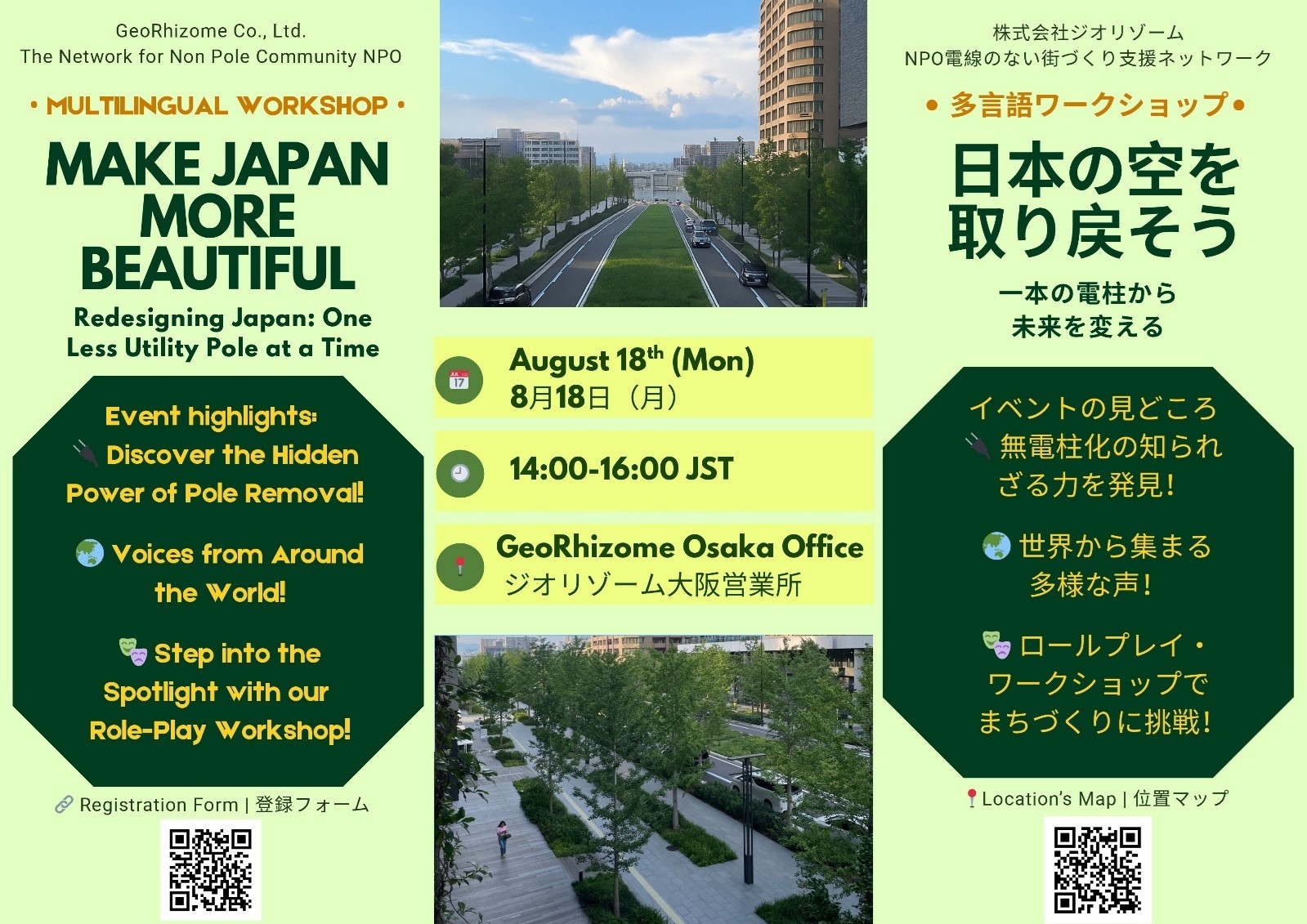The Japanese translation of the article is available here.
Basic information
Time and Date: 14:00–16:00 Monday, August 18th 2025
Location: 1F Meeting Room, GeoRhizome Osaka Office
Moderator: Anh Van Bui
Participant: James Cusick, Junko Cusick, Taiji Tsukada, and Mase Tsubasa
Schedule
14:00-14:15: Icebreaker and Self-introduction
14:15-14:30: Free Discussion Session
14:30–15:15: Short Presentation and Q&A
15:15 – 15:25: Break time
15:25– 16:00: Role-playing
(1) Explanation of Stakeholder Roles (5’)
(2) Brainstorming (10’)
(3) Individual Presentation (20’)
16:00– 16:10: Workshop’s review and feedback
Summary
The workshop began with self-introductions, where participants shared their backgrounds and interests in pole removal. It became clear that people cared about different aspects of the issue, from disaster prevention to neighborhood beautification.
In the Free Discussion Session, participants compared pole removal activities in Japan, Vietnam, and the United States. A key historical case was highlighted: the removal of all electricity poles in New York City after the Great Blizzard of 1888, when snow and ice destroyed telegraph and electric wires.
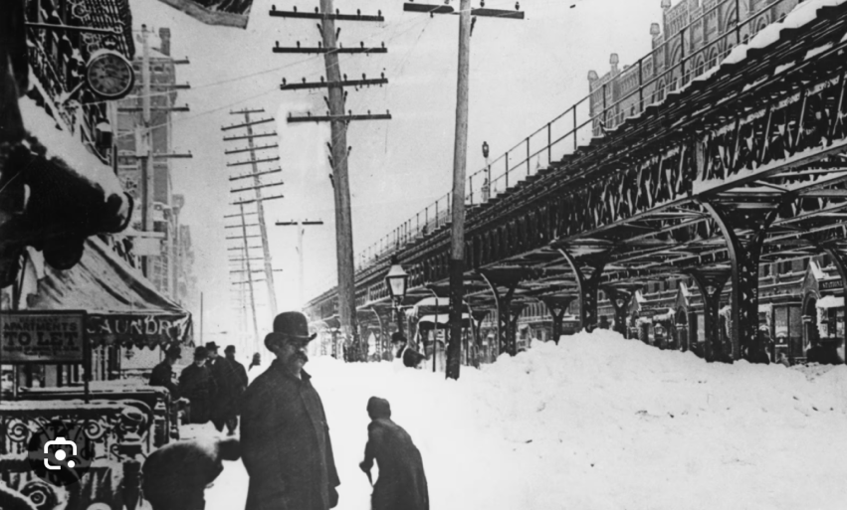
(Picture’s source: Google Images)
The Short Presentation and Q&A included a guessing game with photos of main streets in five countries. Participants were surprised by the “spider web” of overhead wires in Ho Chi Minh City (Vietnam), and impressed by Seoul’s “smart pole” system integrating street lamps, traffic lights, and Wi-Fi access points in South Korea. For one picture, a participant answered South Africa (although the correct answer was Mozambique) on the basis that many Japanese cars were parked in the scene. In the case of the UK’s London photograph, some participants identified it as the Netherlands.
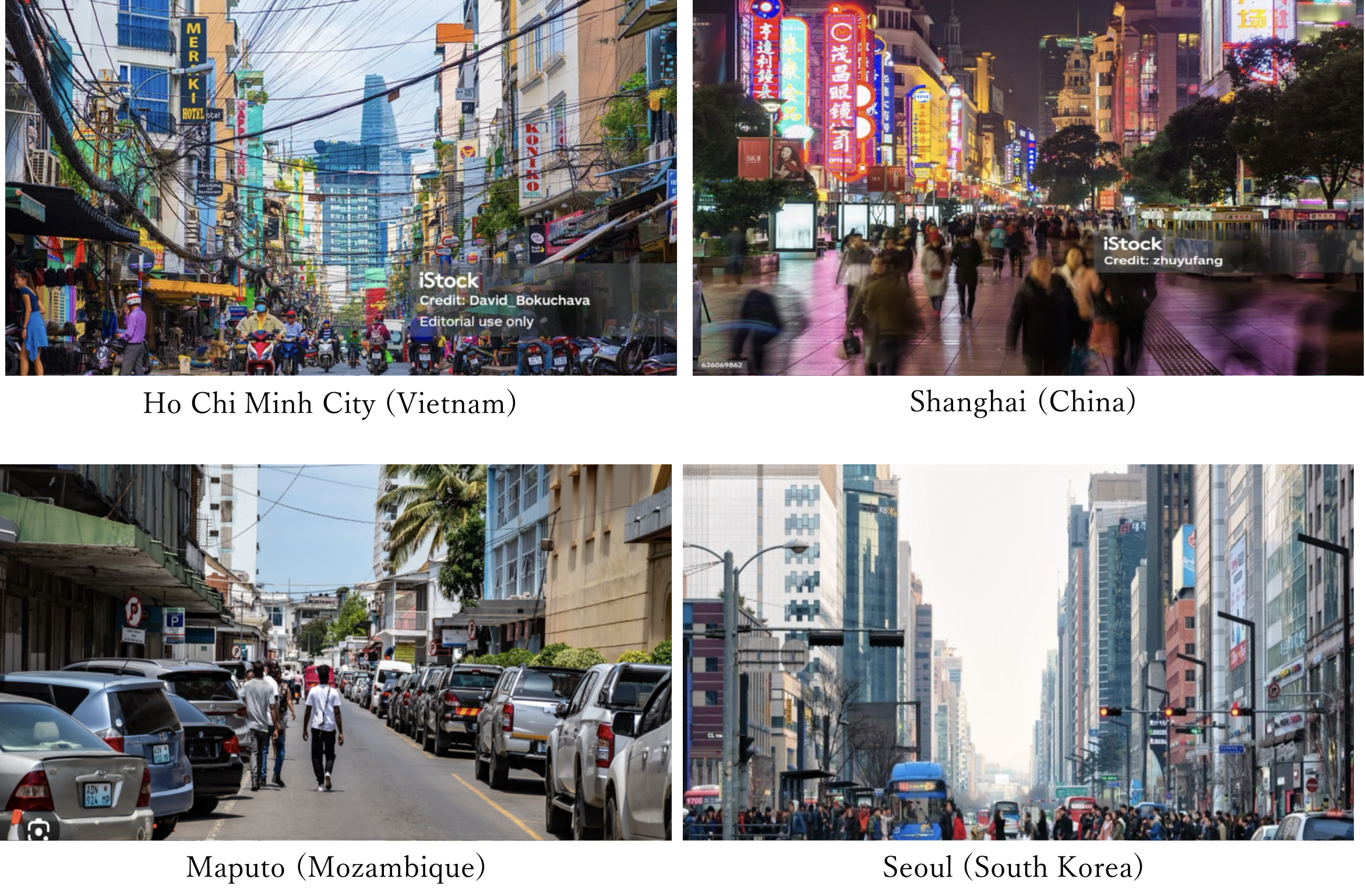
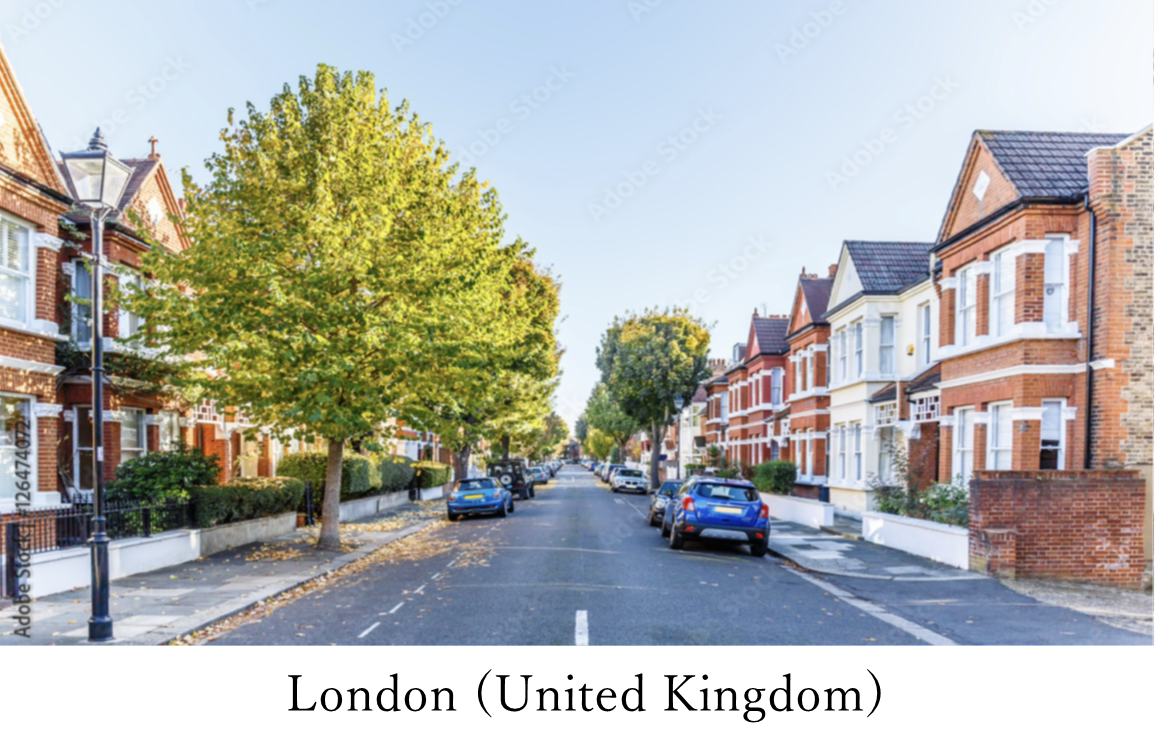
(Pictures’ source: Google Images)
A presentation on advantages and challenges of utility pole removal followed.
- Advantages: Disaster resilience (protection from typhoons, earthquakes, and storms), neighborhood safety (lower electromagnetic exposure), and visual improvement (clearer skylines and open views).
- Challenges: Economic (high initial investment, maintenance costs, and funding burden), technical (complex installation, longer repair times, limited underground space, shortage of construction workers), and geological (difficulties in areas with rocky soil or high water tables).
In the Role-Playing Session, participants assumed the roles of different stakeholders:
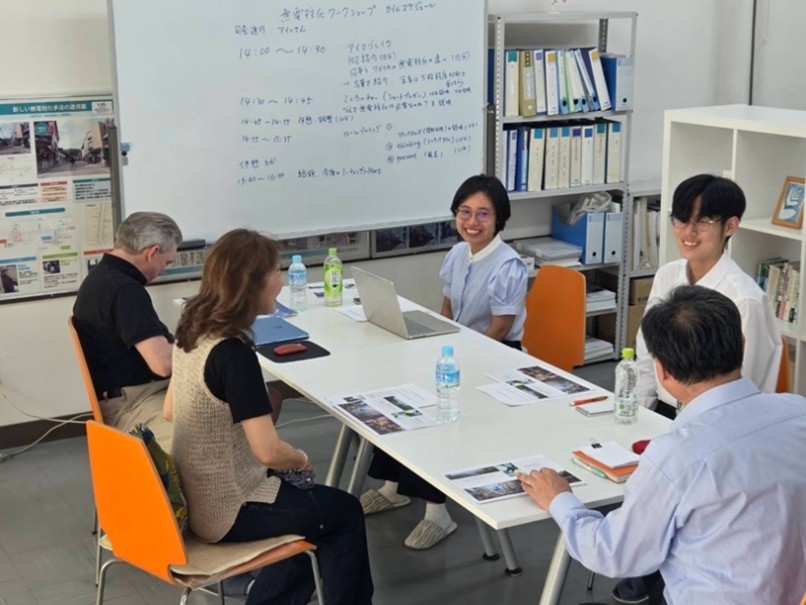
- City Official (James) emphasized the importance of focusing on budget allocation, resource distribution, and the division of roles. He further noted that while the principle of competition is necessary, the role of NPOs in supporting implementation is also of critical importance.
- Local Resident (Junko) emphasized on safety and beautification. Moreover, while disaster preparedness is of course important, the promotion of underground utility lines should be approached more as a business opportunity. For example, unused utility poles could be recycled as cement materials, and undergrounding technologies could be offered to developing countries. The participant also pointed out the need to dispel the negative image that areas crowded with utility poles and wires are unsafe or poor, like the “broken windows effect.” She further highlighted that, much like the vacant housing issue currently facing Japan, the lack of effective policies has left the utily pole problem unaddressed. Therefore, she suggested that the utility pole issue should be tackled with clear prioritization.
- NPO Representative (Tsukada) supported community engagement. He also raised questions about whether high-voltage power lines pose a risk of forest fires or whether there are any effects from electromagnetic waves. It was also suggested exploring the possibility of undergrounding utility lines at shallow depths by making use of Japan’s advanced insulation technology. However, it was noted that shallow undergrounding of high-voltage lines is difficult and carries significant risks.
- Tourist (Tsubasa) shared the visitor’s perspective on aesthetics. He suggested increasing tourism taxes for wealthy travelers to better allocate budget resources. He also emphasized the importance of prioritizing public safety and security.
- Utility Company Staff (Anh) pointed out the lack of awareness that utility poles and power lines can cause negative externalities (so-called public nuisances). On the other hand, she also raised concerns regarding costs and technical challenges.
Through these perspectives, the group acknowledged that while pole removal is critical for both daily life and disaster resilience, financial and technical barriers remain. Participants concluded that successful implementation requires cooperation among government, private sector, and NPO/NGOs, and that we need to be creative in generating new venues for funding to make large-scale pole removal possible.
Participants’ Feedback
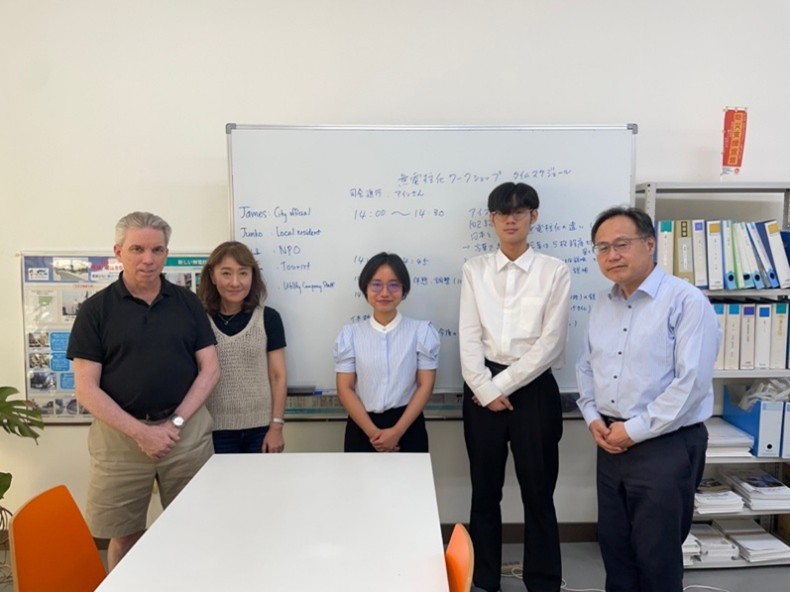
James Cusick:
Anh–san, thank you for organizing the workshop. I thought you did a tremendous job facilitating the meeting. Personally, I felt I had ample opportunity to provide input and also to learn from the other participants.
I do have a few further ideas for you which I will list below. But first, regarding note taking, just a little suggestion. In my experience, the facilitator is usually too busy guiding the session to take copious notes in parallel. Quite often what people do is ask for a volunteer to take notes. Usually someone will offer. This gives them something to do and frees up the facilitator to concentrate on the flow of the meeting. Of course, the facilitator can take notes also and then combine theirs with the volunteer note taker.
Now, just a few thoughts on undergrounding:
-
- Push and pull: I think the NPO and other advocates for undergrounding can push the effort. However, there also must be some players in the community who want to pull the approach in. Building these connections is essential to success.
-
- Showcase tours: Perhaps one way to build excitement is through showing people success stories like the Umekita-Koen area where we visited the Ritsumeikan office. I think when you see traditional neighborhoods with distracting overhead wires in comparison with a cleanly built out area, the aesthetic superiority becomes clear.
-
- Media strategy: I have a contact who wanted to attend the workshop but was busy working on that day. He works for Kyoto Journal (https://kyotojournal.org/). He is very experienced in media matters, and we will be meeting next week to discuss his ideas on promoting the undergrounding efforts of the NPO. I will advise on the results of this meeting.
-
- Hook: I think in promoting undergrounding we should start with a lead message which most people can resonate with, for example, making Japan more beautiful, improving safety, and expanding economic activity. Such a message should be pointed, clear, attractive, and repeated in the same way often.
-
- Disarm common arguments: I have noticed that people resist undergrounding along certain common themes including cost, priority, and scale. I think it might be useful to list a couple of these common arguments and provide answers up front so people do not have to think about why undergrounding would not work.
-
- Provide a clear financial model: The cost of undergrounding should be clearly stated. For example, per Kilometer cost for new construction, per Kilometer cost for conversion of existing area, etc. Also, what are the potential funding models to defray these costs?
-
- Quantify disaster recovery benefits: Just like the investment requirements need to be clear so should the benefits. For example, in theory, if a city saw its overhead wires undergrounding what would be the expected speed of first responders following a disaster? Or what would be the reduction in cost in recovery, etc. Can we put a number on the tourist popularity of a beautiful photo spot for Mt. Fuji?
Junko Cusick:
First of all, Anh-san and everyone, thank you very much for your hard work.
I had the chance to meet Anh-san once before the workshop, and right away I was impressed by her intelligence and brightness. In addition, I found her to be truly international-minded and open. During the workshop, she demonstrated exactly what I had felt—and even more—making it a truly enjoyable experience for me.
Despite our rather unpolished, amateur opinions, she guided us patiently and allowed us to share our thoughts freely without any stiffness. I feel grateful that this was possible thanks to the culture of The Network for Non Pole Community NPO and the opportunity that Tsukada-san created for us.
Although Anh-san seemed experienced in planning, preparing, explaining, and facilitating in both Japanese and English, I imagine it must still have been a lot of work. It makes me very happy to know that such an outstanding young person is here in Japan. I sincerely hope she will continue to pursue her studies and other endeavors freely and passionately, and that she will flourish in her future activities.
For disaster-prone Japan, undergrounding utility poles is a crucial issue, and yet the progress is frustratingly slow. I believe discussions from an international perspective will surely be valuable. I look forward to meeting everyone again, even in a casual setting, and I pray that our efforts, however small, will contribute to moving undergrounding in the best possible direction. Thank you very much once again!
Taiji Tsukada:
First of all, I would like to express my deep gratitude to Mr. and Mrs. Cusick, who supported our project by sharing their advice, reaching out to their acquaintances, and even collecting opinions about undergrounding utility lines.
Regarding the main topic, I would like to commend Anh, who served as the facilitator and organizer of this workshop. She performed her role as a facilitator admirably, making the meeting both engaging and insightful, which led to excellent outcomes. Despite having a time-limited schedule, she successfully handled planning, negotiations, execution, and follow-up.
When I asked her, she mentioned that she has considerable experience with this type of discussion, which made me notice aspects different from Japanese students.
Moving on to specific evaluations of this workshop. Anh has a solid grasp of how to conduct group discussions. The schedule was well structured, with time allocations and the purpose of each session clearly communicated to participants. The structure allowed participants to feel at ease while encouraging each person to express their opinions, creating a true “discussion” experience. In Session 4 (role-playing), she designed activities that prompted participants to consider undergrounding from various perspectives. After each presentation, other participants could add their thoughts, enabling lively discussions that were carefully anticipated in advance. Mr. and Mrs. Cusick, who are well-versed and deeply interested in undergrounding, provided strong support for Anh’s planning. However, the fact that their opinions were successfully drawn out and that the meeting ran smoothly was largely due to Anh’s thoughtful session design and the welcoming atmosphere she created.
I believe this workshop model could be applied to student-run debate sessions in Japan as well as meetings for deeper discussions with international participants. Personally, it was extremely informative and educational for me.
Anh, good job! Thank you very much.
Tsubasa Mase:
For me, this workshop was an opportunity to broaden my perspective on utility pole removal, not only within Japan but also globally. Being able to directly compare Japan’s pole-filled landscapes with those of other countries through photographs was visually stimulating. The program offered many opportunities for active engagement—such as quizzes and discussions on pole removal from different standpoints—rather than just passive learning. Thanks to this, I was able to deepen my knowledge while also enjoying the process.
It was my first time participating in a discussion with international guests, so I was quite nervous, but it turned out to be an extremely valuable experience. Mr. and Mrs. Cusick are very knowledgeable about utility pole removal. In addition to their expertise, they shared many fresh ideas drawn from their global work and travel experiences, as well as from their research and specialized knowledge as an university lecturer. Hearing opinions and facts that I would not have thought of myself, including perspectives different from my own, was very meaningful. It made me aspire to one day take part in discussions with the same depth of knowledge and experience.
I would like to sincerely thank Mr. Tsukada from the NPO for giving me the opportunity to participate, Ms. Anh for her work in planning, organizing, and moderating, and Mr. and Mrs. Cusick for joining us despite their busy schedules.
Anh Van Bui:
In this workshop, I learned the importance of first clarifying why utility poles should be removed, as understanding the purpose behind the action helps build stronger justification and public support. The discussion of international case studies was especially insightful, as it showed how different countries approached the issue and the driving forces behind their decisions, such as disaster resilience, safety, and urban design. It also raised the question of whether lessons from developed countries can realistically be applied in developing contexts, where financial and technical resources may be more limited.
Another valuable part of the workshop was the emphasis on creative solutions for funding. Ideas such as the Japanese government selling akiya (unused houses) or akichi (vacant land), or exporting high-technology underground wiring systems, showed how innovative thinking can generate venues for action. The workshop definitely deepened my understanding of both the challenges and possibilities of pole removal.
Furthermore, as the workshop’s moderator, I was responsible for facilitating the session. As I was occupied with managing the proceedings and engaging with the participants, I was unable to take sufficient notes, which created difficulties in summarizing the content afterward. Moving forward, I intend to prepare more thoroughly and adopt more effective strategies in advance, so that I can take more detailed notes during workshops and meetings and further develop my ability to record information efficiently.
5th Utility Pole Removal Photo & Movie Contest – Invitation
Our NPO is holding a photo & movie contest to collect wonderful streetscapes and scenery without utility poles.
We invite you to submit your photographs showcasing beautiful landscapes free of poles and power lines, whether captured overseas or within Japan.
If you have photos you can share, please kindly send them to the email address below.
We look forward to receiving them!
Email: nponpc.t@gmail.com
NPO Secretariat: Tsukada
Details of the contest can be found here:
https://nponpc.net/info/photomovie_vol-5/

